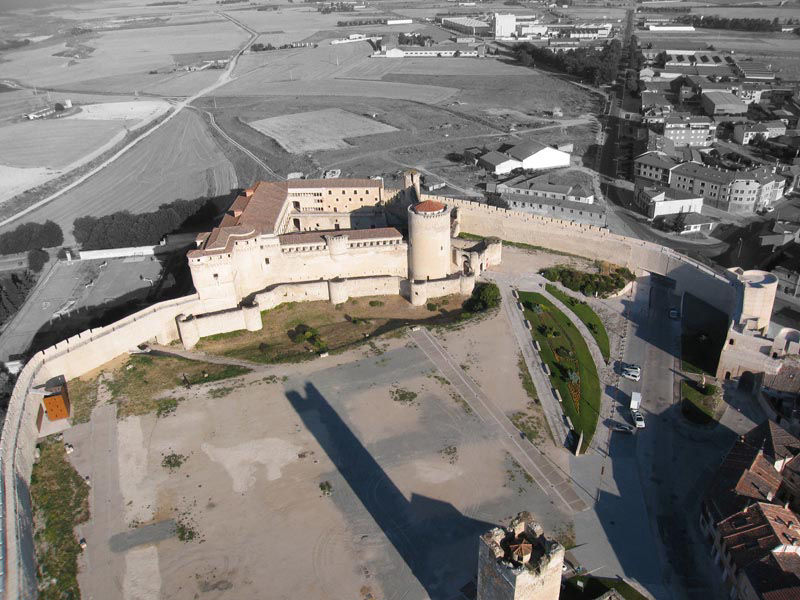

NEW ACCESS TO THE WALL. INTRODUCTION
“Shall the collection of taxes be used to repair the walls…”This phrase can be found in a text dating back to 1264, an announcement made by King Alfonso X to the town of Cuellar which proves that the walls existed before the 13th Century, as can also be inferred from the fortified towers, gates and arches in which brickwork alternates with stonework.
The construction of the city walls of Cuellar that you can see with the audioguide dates back to the 12th Century. They were rebuilt and extended during the 14th and 15th centuries for defensive purposes mainly using limestone mortar and stone (stonework). The Moorish technique of using brickwork is present in the more ancient gates and fortified towers, such as the Gate of Saint Basil, the fortified tower to the southeast of the castle, the Arch of Saint Andrew and the remains of the Gate of the Caves. The construction has two distinguished walls: the citadel wall, which starts from the castle and reaches the highest elevation point, and the city wall, which is longer and surrounds the town.
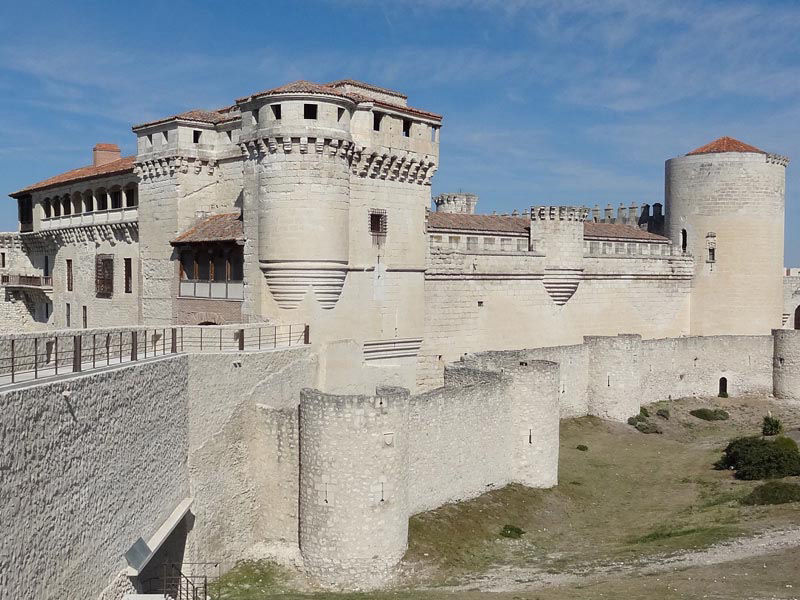
This audio-guide includes a walk along the Ronda Way, where you can enjoy a bird's eye view of the Moorish churches, the medieval urban layout and the Sea of Pine Trees.
To access the walls, you must visit the Tourism Office beforehand, which is at the castle. For further information call 921 14 22 03 or visit www.cuellar.es.
FIRST STOP: THE CASTLE
Once we reach the Ronda Way with the audioguide, the first thing that we encounter is one of the nicest views of this breathtaking castle-palace.
Southeast Tower
Although the first written documents mentioning the castle date back to the 13th Century, when King Alfonso X the Wise authorised the allocation of taxes to repair the castle, the primitive architectonic remains of this fortified tower - an ancient Moorish gate - belonged to the 11th Century. Hiding behind the tower’s exterior ashlars, we can see Moorish brick arches, mud walls, windows and narrow passageways dating back to the Middle Ages.
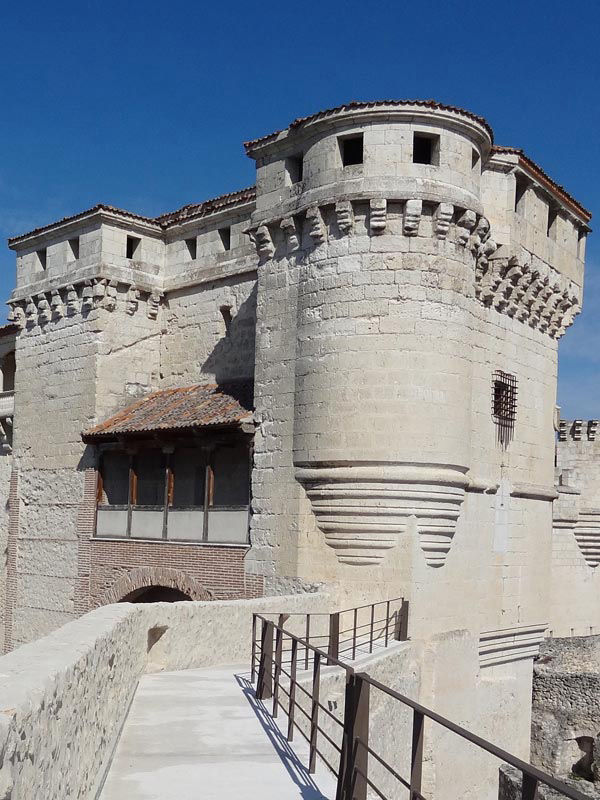
This Southeast Tower is known as the “The Tower of Memory”, as theatre plays are performed for the enjoyment of anyone who comes to the castle during the weekend. The visitors will be able to share this space with the different characters that inhabited the castle via the magic world of theatre.
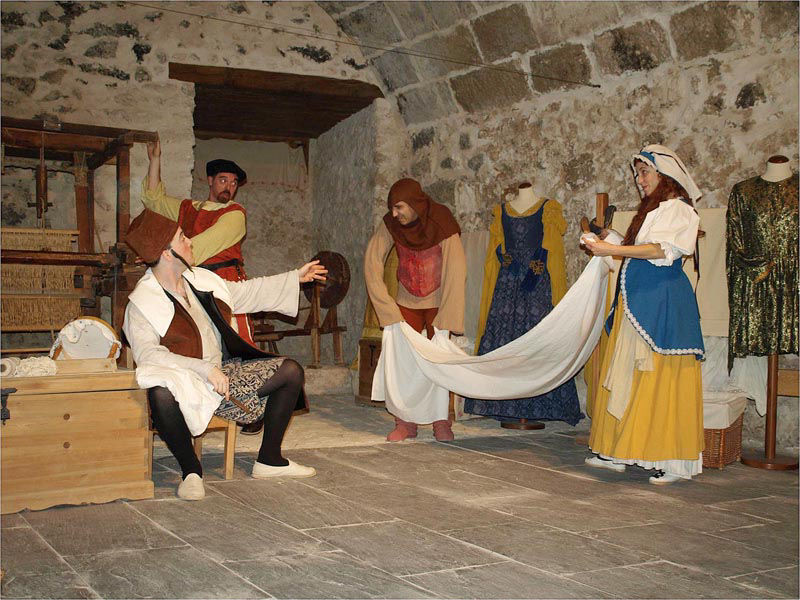
Moat
The moat excavated in front of the barbican, which was used to protect the inner wall and the castle's wall, can still be seen to this day with the audioguide.
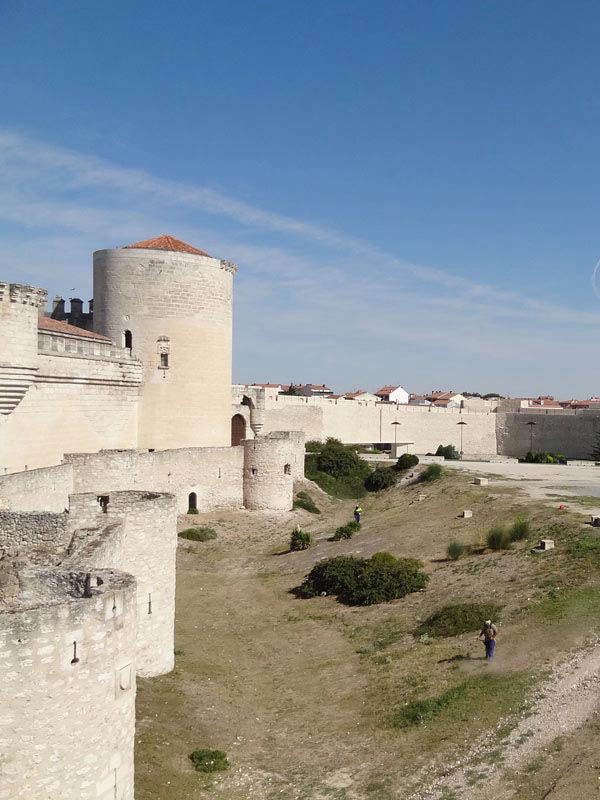
Barbican
This is the smallest wall and it extends in parallel to the castle’s eastern wall joining both access gates of this impressive fortress. The barbican is completed by five small semi-circular towers that house firing cells with their respective portholes.
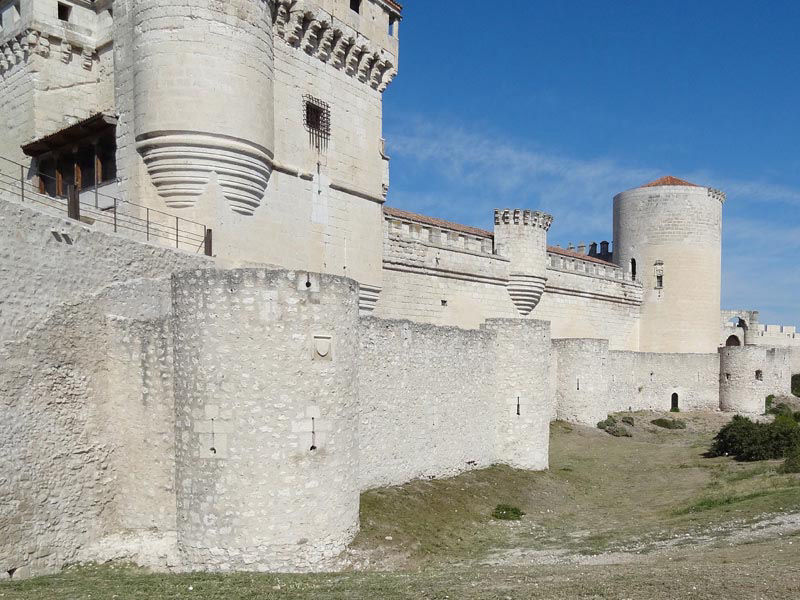
Death Trap
Space between the barbican and the castle wall. It is considered a passageway-trap, as both gates could be closed once the enemy entered.
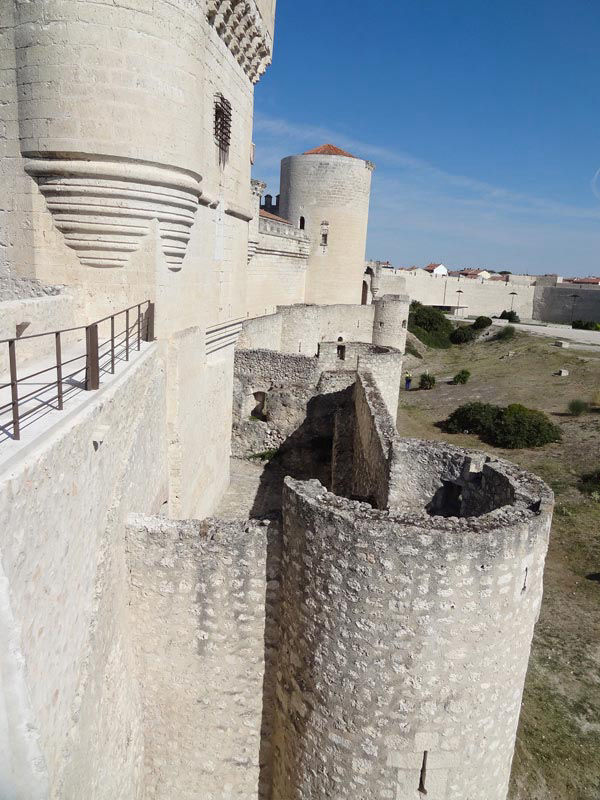
Tribute Tower
Commissioned by Mr. Alvaro de Luna and built in ashlars, it stands out because of impressive height and circular form. It has two rooms with ribbed arches: one on the ground floor, used as the Tourism Office, and another on the top floor, which houses the Historic Archive of the Dukes of Alburquerque that you can visit with the audioguide.
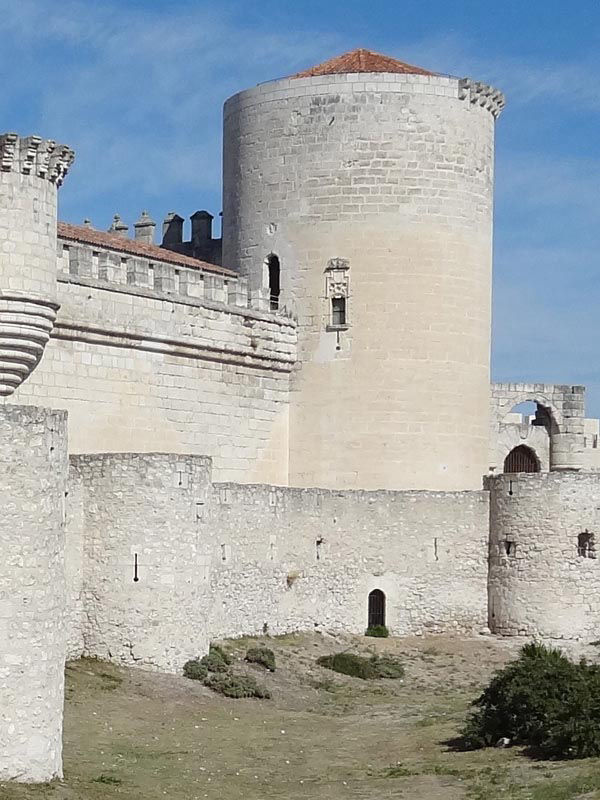
We continue the audio-guided tour along the wall towards the east until we reach the Church of Saint Martin, where we will make the next stop.
SECOND STOP: SAINT MARTIN AND SAINT BASIL
The Church of Saint Martin
This church was erected on a ground plan with a central nave and two closed transept wings with three semi-circular apses, in which, over a stonework socle stand out a series of brick arches doubled in superimposed and squared stretches, which are a characteristic of Moorish architecture in the churches of Cuellar. Its slender tower, built after the temple, stands out and occupies part of the Moorish atrium on the west side of the church. Nowadays, this church houses the Interpretation Centre of Moorish Art, a beautiful trip through the Middle Ages via images, music and sound.
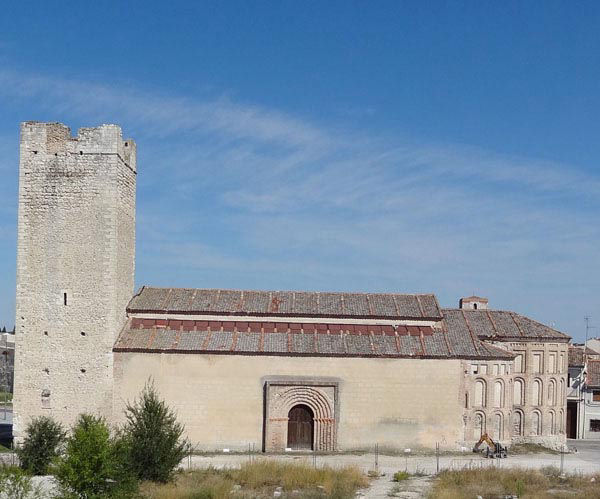
Gate of Saint Basil
From the 12 gates that the walls once featured - six of them in the citadel, the Gate of Saint Basil is the only one that has been preserved practically untouched since the last changes carried out by the Dukes of Alburquerque, that you can visit with the audioguide. It was originally called the Gate of Robledo; when the Convent of Saint Basil was built in the 18th Century, it was renamed the Gate of Saint Basil.
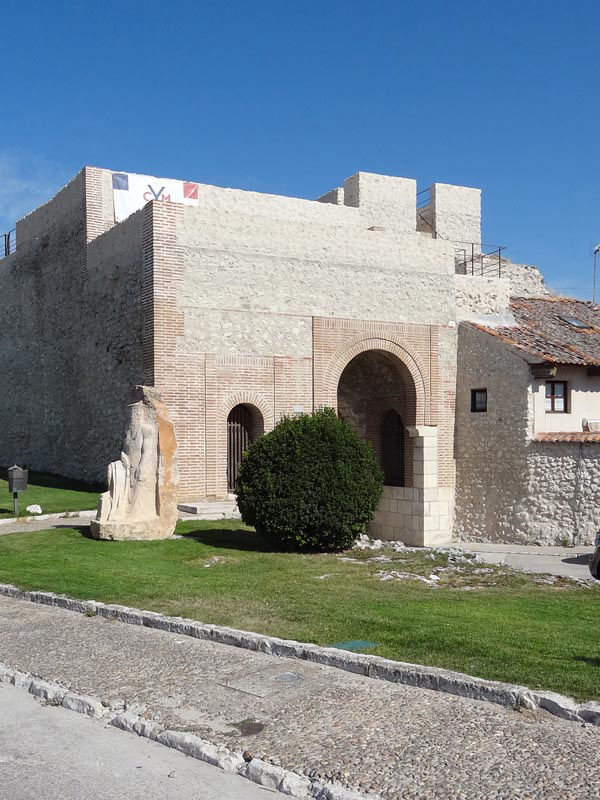
Its Toledo-type Moorish architecture is predominant; the layers of bricks among the limestone and mortar stonework, the brick arches with wide layers of lime mortar and the passageways towards the parapet walks stand out.
The Castle Esplanade
What is known as Showground is the space in front of the castle which has been occupied since the Iron Age. It was first occupied by Celtiberians; remains of several settlements have been found from the 4th to the 1st century BC (tiles, a furnace, loom weights, adobes, housing,...).
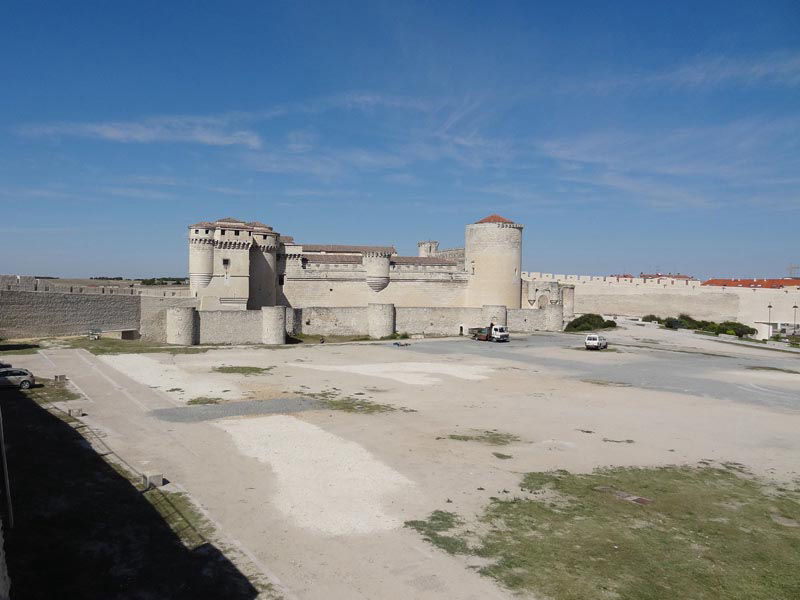
When the Old Age began, it was abandoned - possibly forced by the arrival of the Romans - and it was not occupied again until the Early Middle Ages, a period in which it became a meeting point for public events such as tournaments and jousts. During the Contemporary History, it was used as a cattle fair; it is currently the stage for the multisector fair.
The walls
The esplanade we can see with the audioguide is practically a closed enclosure, as it is surrounded by the walls, the castle and the Church of Saint Martin. Although it has not been proven, some scholars have suggested the existence of another wall in this esplanade that, from the Gate of Saint Basil, continued towards the tower of the Church of Saint Martin and ended at the gate that gave access to the Duke's Gardens.
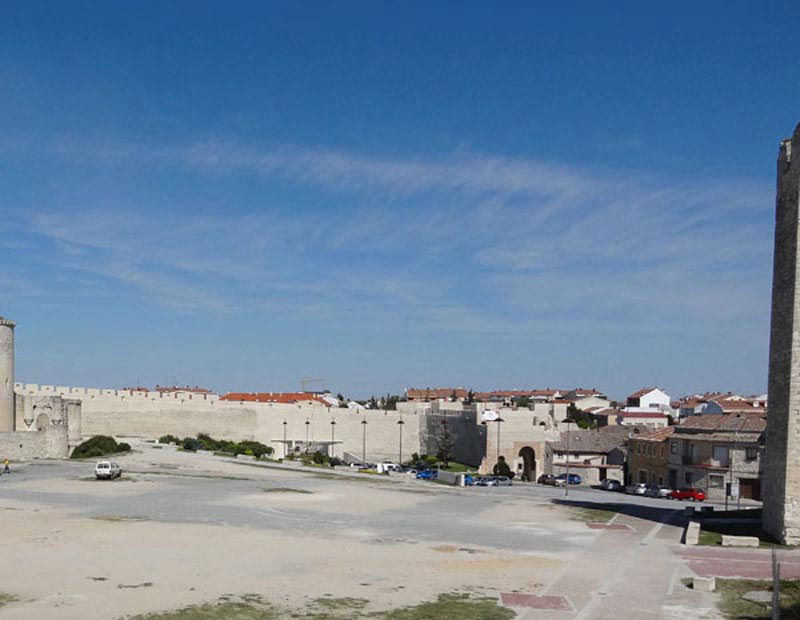
Both extensions of the wall can be currently visited with the audioguide, which start from the castle and close the first wall enclosure of the medieval citadel. The main access to the citadel from the exterior was carried out using the Gate of Saint Basil, where there was an opening in the south wall that connected the esplanade directly with the Duke's Gardens.
Continuing our route along the Ronda Way, we reach the fortified tower on the Gate of the Caves, from which we can see outwards and enjoy the natural environment of the region of Cuellar, which will be described in the next section of this audioguide.
THIRD STOP: GATE OF THE CAVES AND ITS SURROUNDINGS
¨¨ Sea of Pine Trees” in the land of Segovia
The Land of Pine Trees of Segovia, is an extensive land of maritime pines where several routes can be organised crossing the forests, riverbeds and dams. For further information, see Network of Paths in the Region of the Town and Land, and the Fishermen Path.
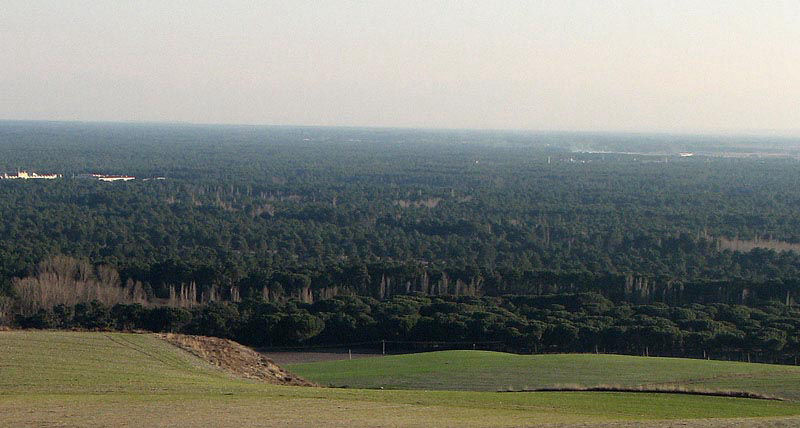
The municipalities of Carbonero, Arroyo, Sanchonuño, Chatún, Pinarejos, Narros, etc. can be seen from this wall.
This region is not only famous for its extension of pine trees, but also because of the large amount of Moorish influence present in its municipalities. , especially in Samboal, Pinarejos, Campo de Cuellar and Narros de Cuellar. There is also Moorish architecture. in San Cristobal de Cuellar, Chañe, Fresneda de Cuellar, Villaverde Iscar, Fuente el Olmo de Iscar, Navas de Oro, Gomezserracin, Chatun, Dehesa de Cuellar, Lovingos and Fuentes de Cuellar.
Gate of the Caves
Despite the lack of graphic documentation on the defensive complex of this gate, it can be inferred from the Moorish remains preserved in the fortified tower of the missing gate (brick corners and courses between the mud walls with lime and stone) that it dates back to the 12th Century.
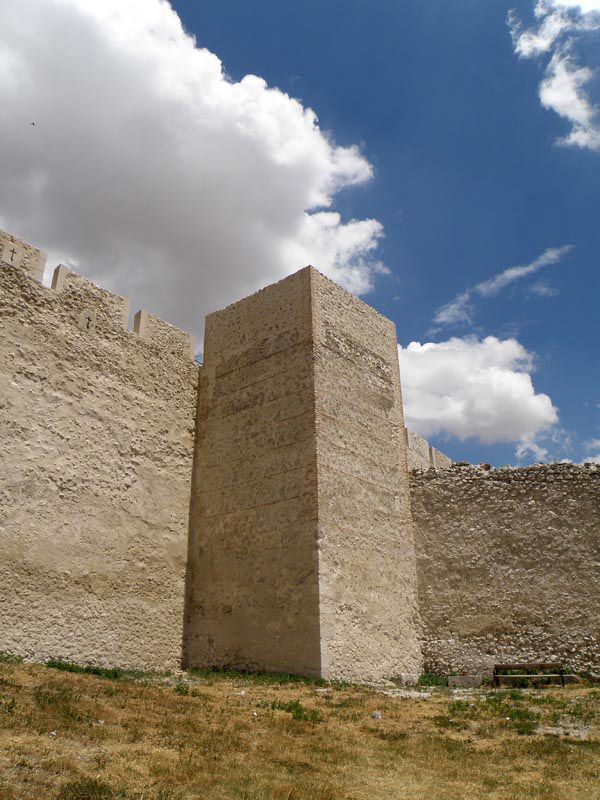
Second wall enclosure
The city wall starts from the Gate of the Caves towards the southeast, where we can see the fortified towers, the Gate of Exangel, the battlements in Avila Street, or we can pass through the missing gates of Trinity and Saint Peter while we listen to the audioguide.
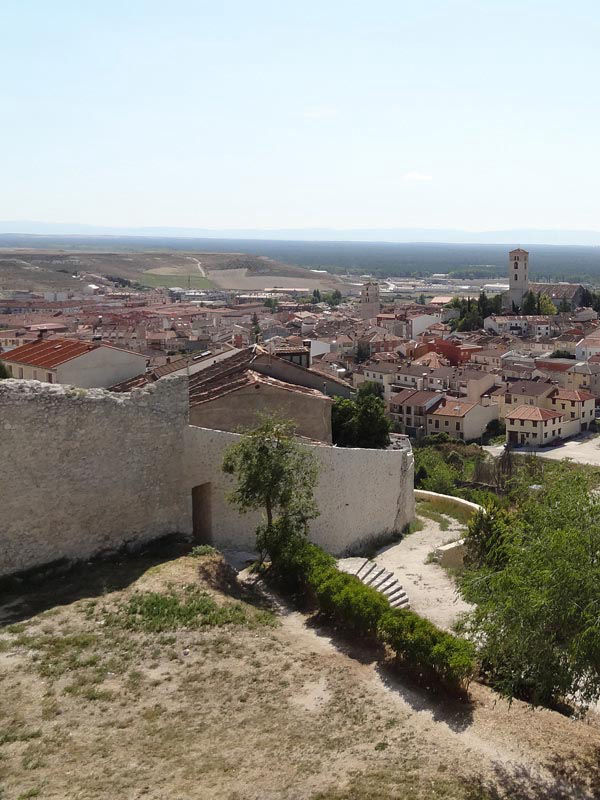
Inner wall or barbican
A smaller inner wall was erected in addition to the city wall, which was built in parallel to the exterior side of the wall and has been recently restored together with the Gate of the Caves.
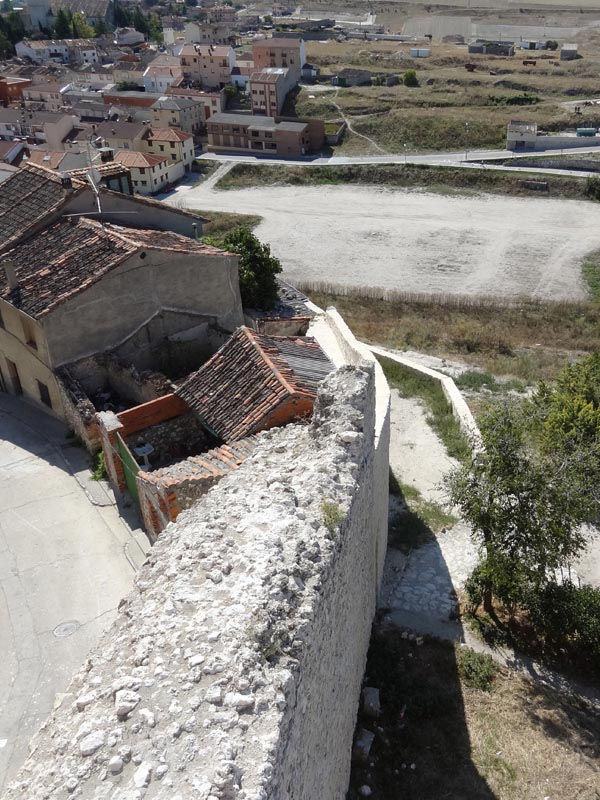
Windmill
The circle shaped tower known as “El Cubo”, which can be seen in the background next to the park, are the remains of the first windmill documented in Castille and Leon (1496).
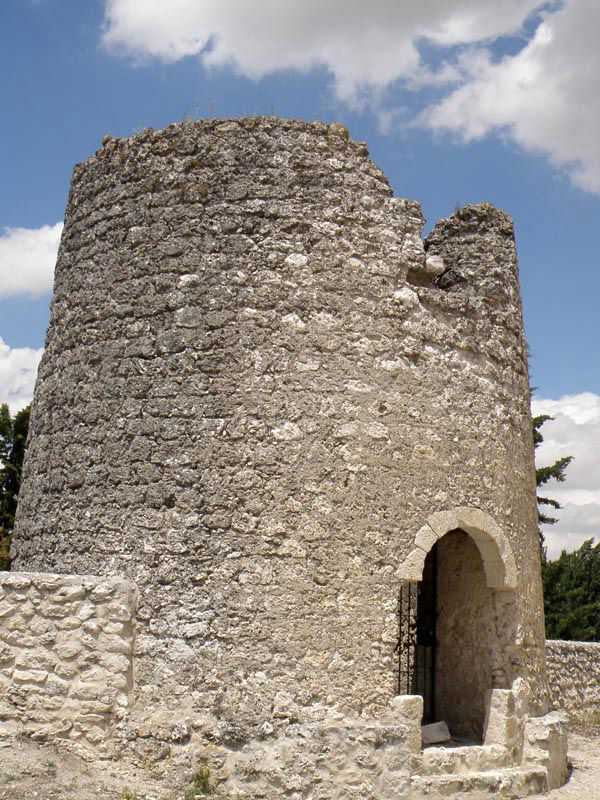
The Duke's Gardens
What in the 15th Century was known as the “Duke's Forest” and currently the “Duke's Garden” is a green area with over thirty tree varieties and over two hundred species of plants and an extension that exceeds eight hectares. You can either go for a walk with the audioguide, organise sport circuits or just enjoy a relaxed environment in the middle of nature. A Moorish Medieval Fair takes place in August.
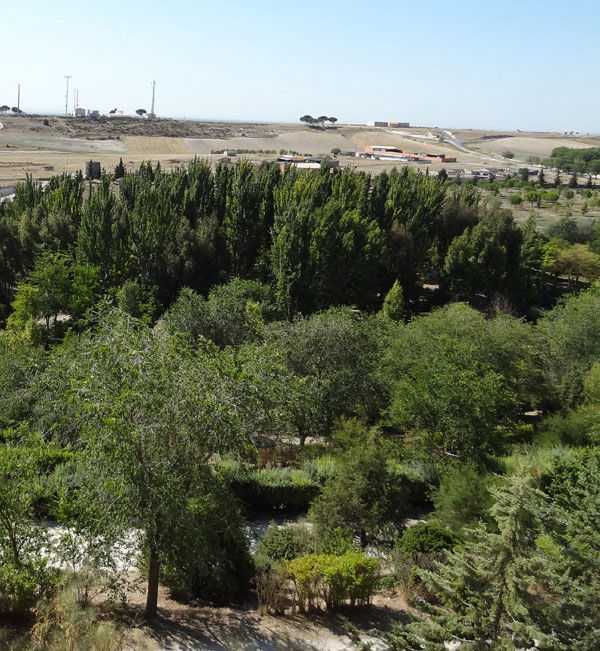
Let's continue the tour along the parapet walks towards the Fortified Tower of Santiago, where we will make the last stop.
FOURTH STOP: FORTIFIED TOWER OF SANTIAGO
We can now see the urban complex of Cuellar, and from the previous point (the Duke's Gardens), we can see the following monuments which are indicated in the different panels that complement this audio-guide.
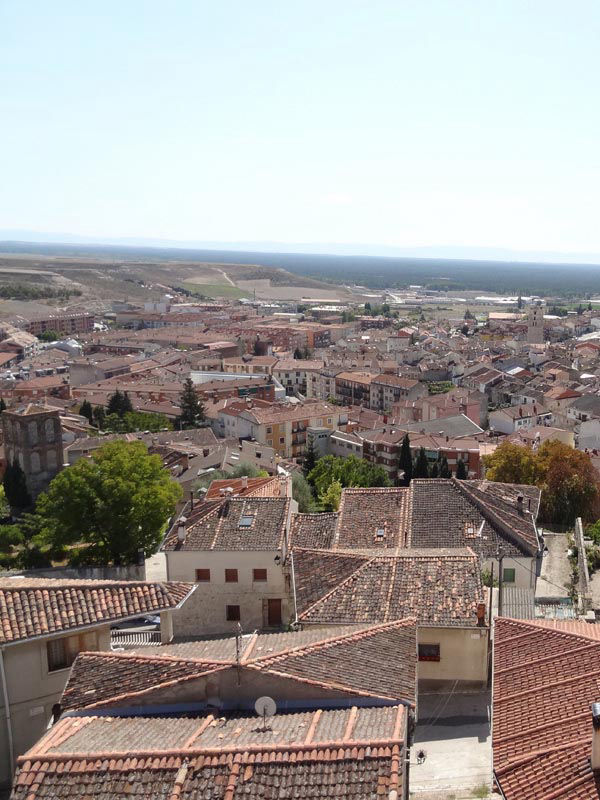
The Church on the Hill
On the hill of the poor areas located in the south of the Town, we can see the silhouette of the Romanesque-Moorish tower, the Romanesque apse, and its wall enclosure.
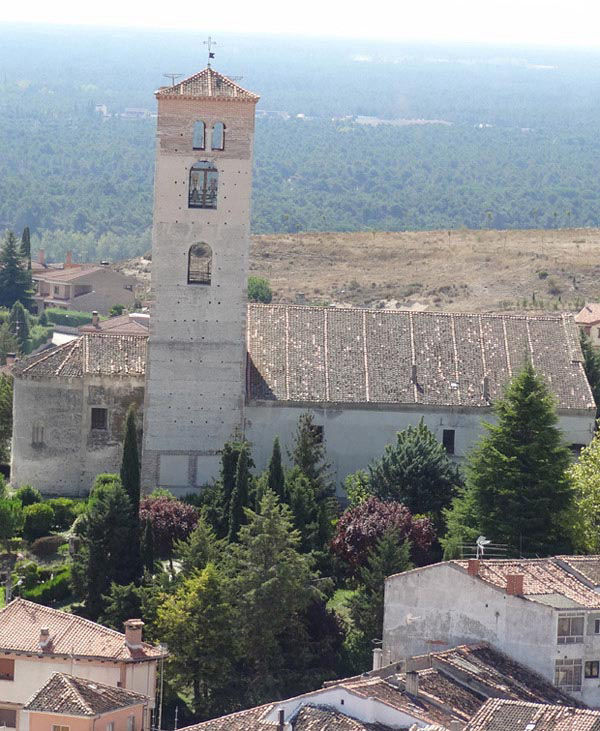
The Church of The Saviour
Its Moorish apse is erected on lamp shaped buttresses. This peculiarity, which can be seen with the audioguide from the outside of the temple, gives this neighbourhood located at the outskirts of the city its name.
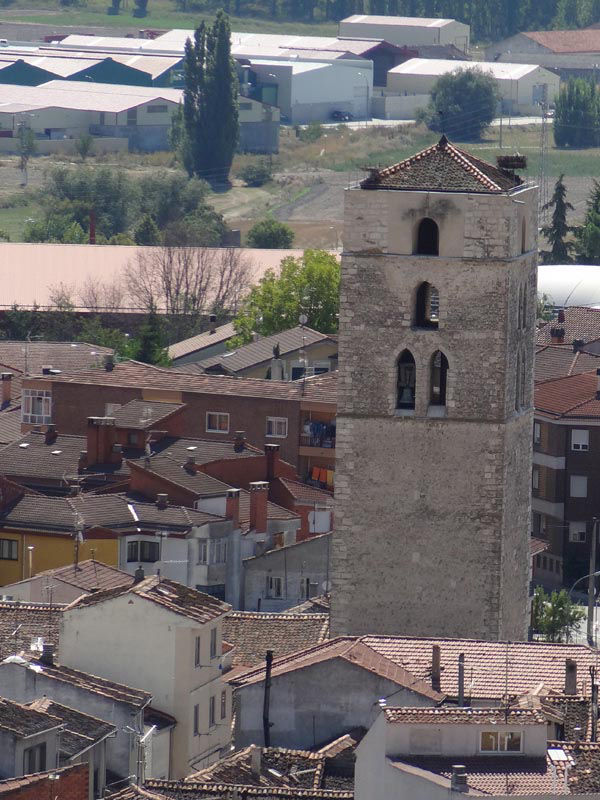
Mountain range with the “Dead lady”
From the “Sea of Pine Trees”, we can see the Guadarrama mountain range featuring the silhouette of the “Dead lady”, a mountain profile full of legends. One of them says, “it is said that centuries ago lived a lady in this area with two children who hated each other; one of them went to live in the area of Madrid and the other in Segovia. One day, they stumbled upon each other when visiting their mother and they started to argue. They got so upset that they started throwing stones at each other. The mother tried to stop them by standing in the way, but blinded by their fury, they continued and killed their mother, who was buried beneath the stones.
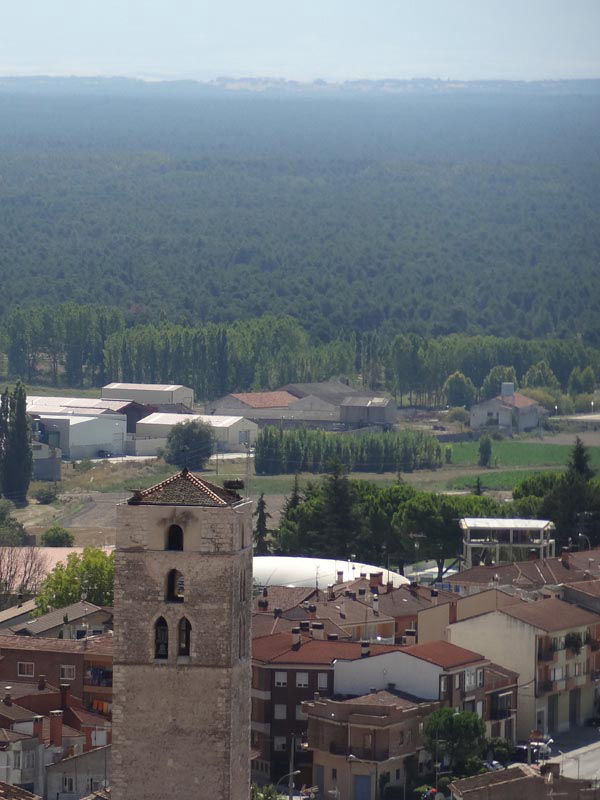
The Fishermen Path
The audioguide suggests you enjoy a bit of nature during a nice walk among the Fishermen path. From its access through exit No. 57 of the A-601 road, a 16 km route can be followed by the River Cega while crossing the largest continuous body of pine trees in the whole of Europe. The path is indicated and the route can be carried out individually or in a group.
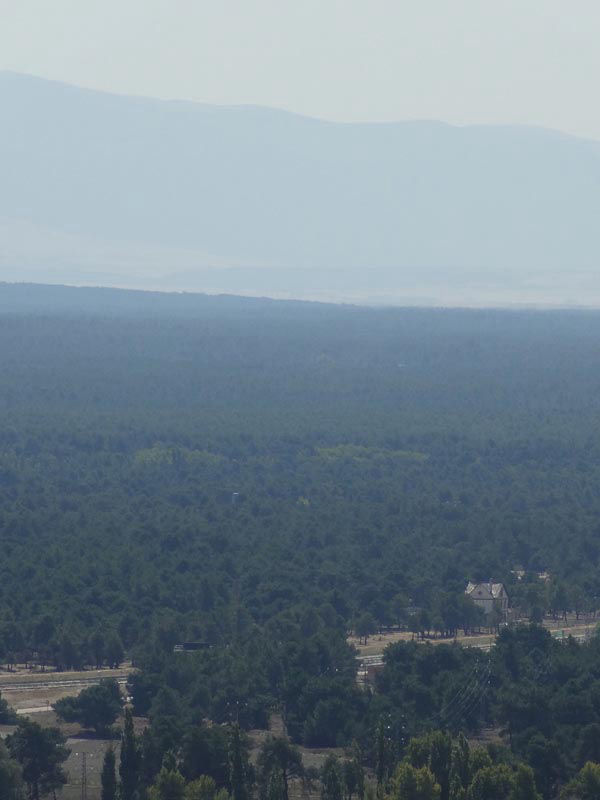
The Convent of Saint Clair
At the beginning of the 16th Century, the daughter of the 2nd Duke of Alburquerque - Ana de la Cueva y Mendoza - ordered the erection of this convent on the remains of another previous monastery in the south of the Town so it could be occupied by cloistered nuns, which still inhabit it to this date. The Gothic-style church and the Renaissance-style of its interior patio stand out.
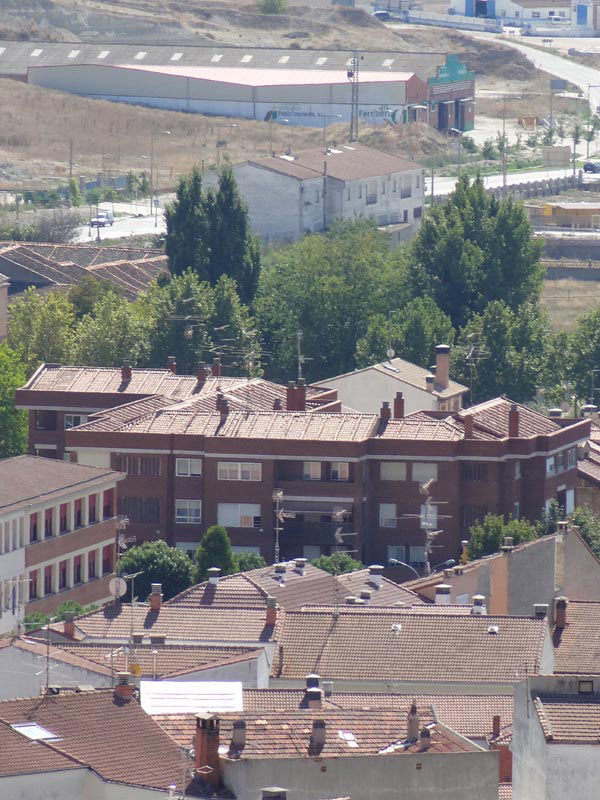
Espadañal-Golf Course
This important wetland has a large extension of water with the most varied fauna in the region, where a significant amount of bird species arrives each year. Next to the Espadañal, a 9-hole golf course offers all golf enthusiasts an excellent environment in which to enjoy this sport.
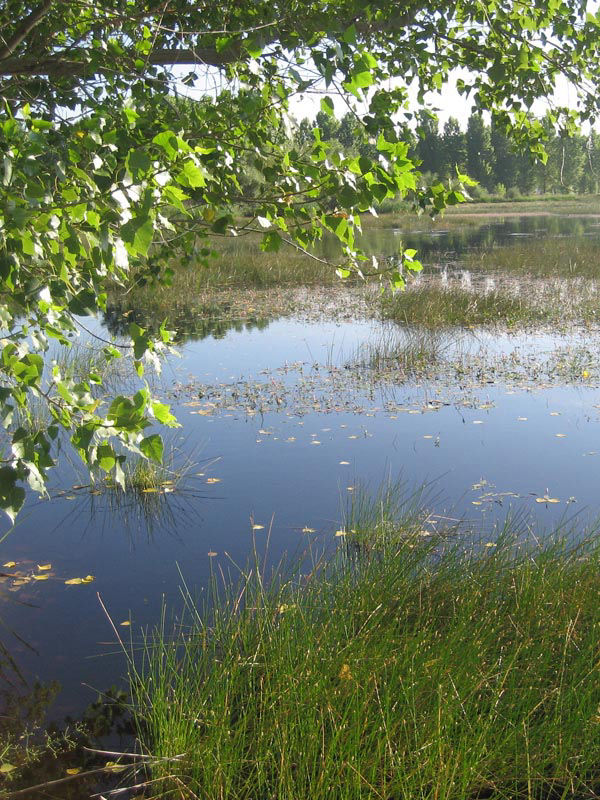
Castilviejo
Next stop of this audioguide, the hill of Castilviejo is the highest point in the municipality. Its name originates from the existence of a castle which was older than the current one, although there are no remains.
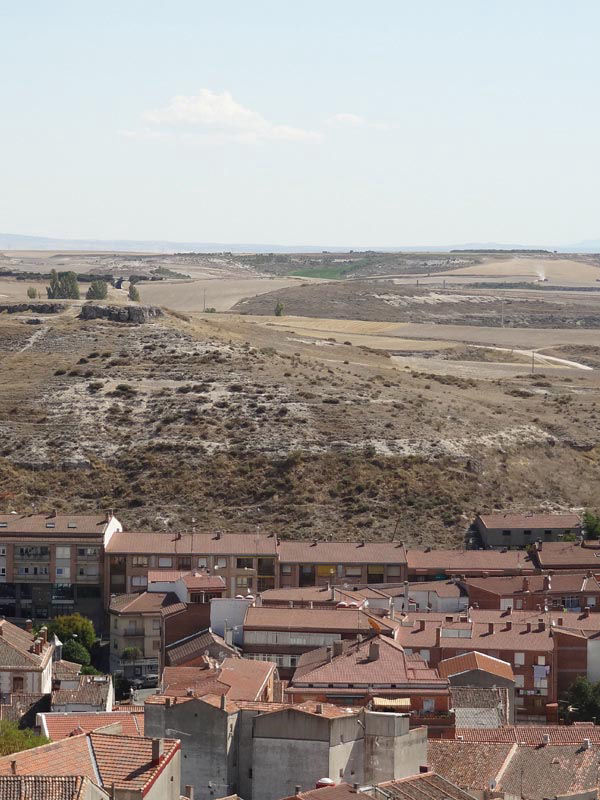
Washing place of Exangel
This garden environment preserves the old washing places located next to the wall of the second enclosure.
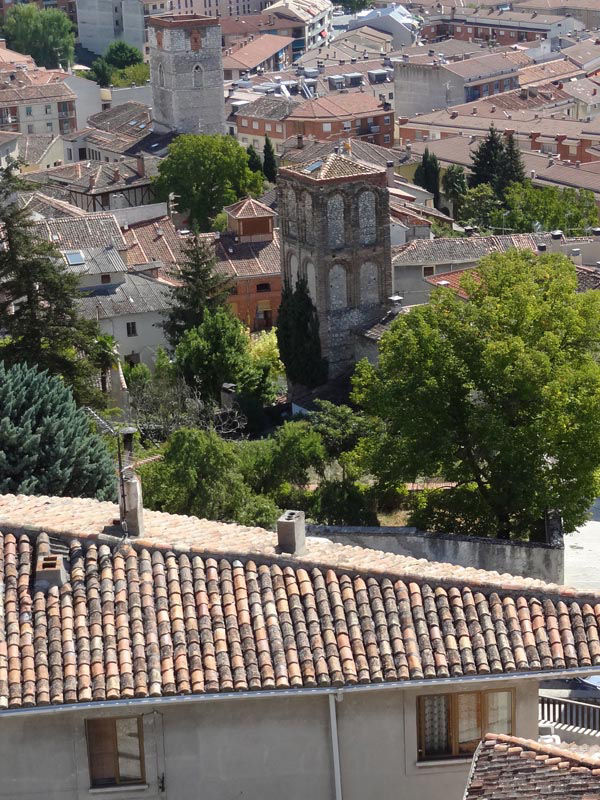
The Church of Saint Peter
This church is believed to be the oldest in Cuellar due to the existence of a document dated 1095 making reference to it. Its defensive features, as it is attached to the wall and adjoining one of its gates - currently missing, the Romanesque gates and its Gothic arches stand out.
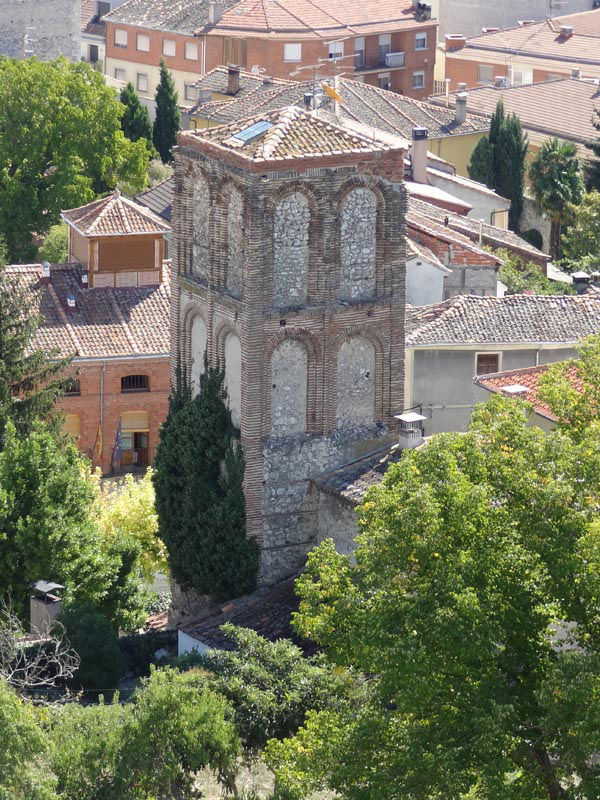
Church and chapel of Saint Tome
Romanesque and Moorish remains can be seen with the audioguide in this church seized in the 19th Century. The 13th Century Gothic-Romanesque chapel is the only part destined to religious use and features niche from the 18th Century in its apse.
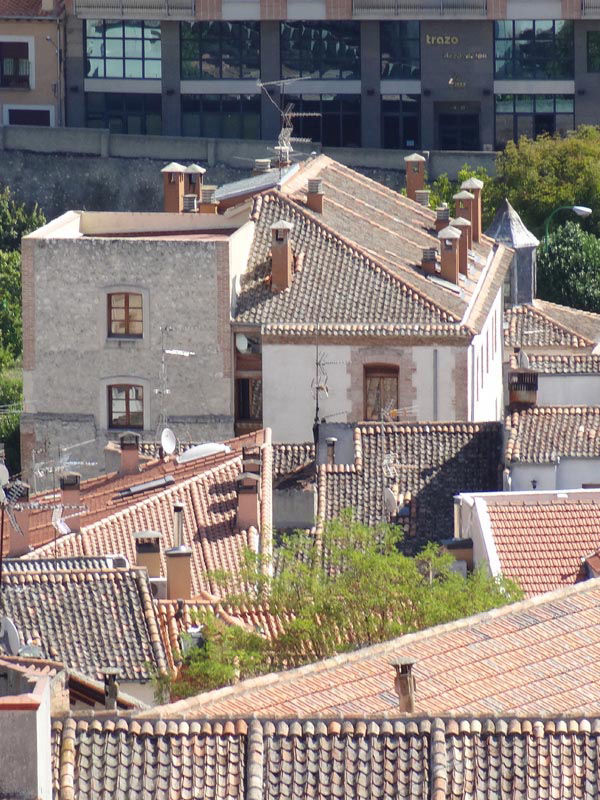
Main Square
This square is noted for its arcade of stone columns, houses with ashlar façades and wooden framework on the top floor. The Church of Saint Michael and the Town Hall complete this square.
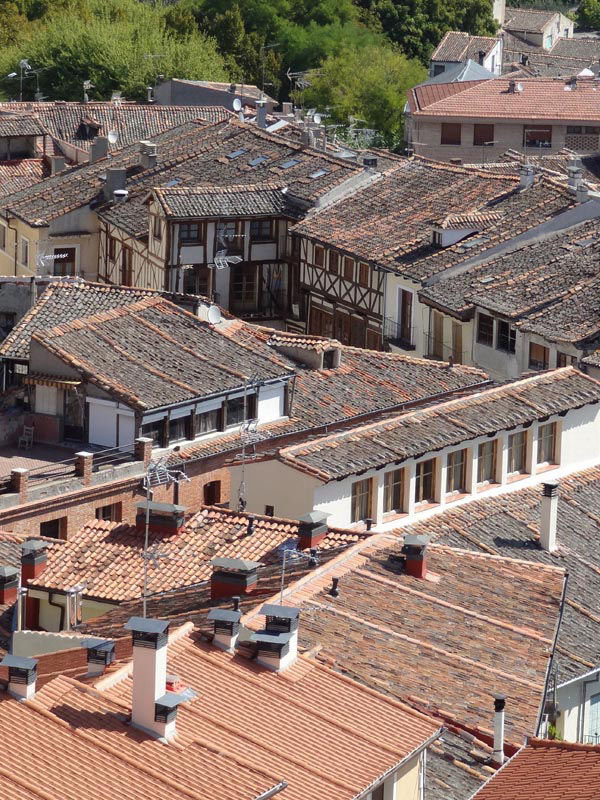
Convent of Virgin Birth
Following the audioguide we arrive at the Convent of Virgin Birth. Located in a Franciscan setting in the outskirts of the town - next to the convents of Saint Ann and Saint Francis, this convent was founded in the 16th Century and was used by cloistered nuns, whom continue occupying it up to this date.
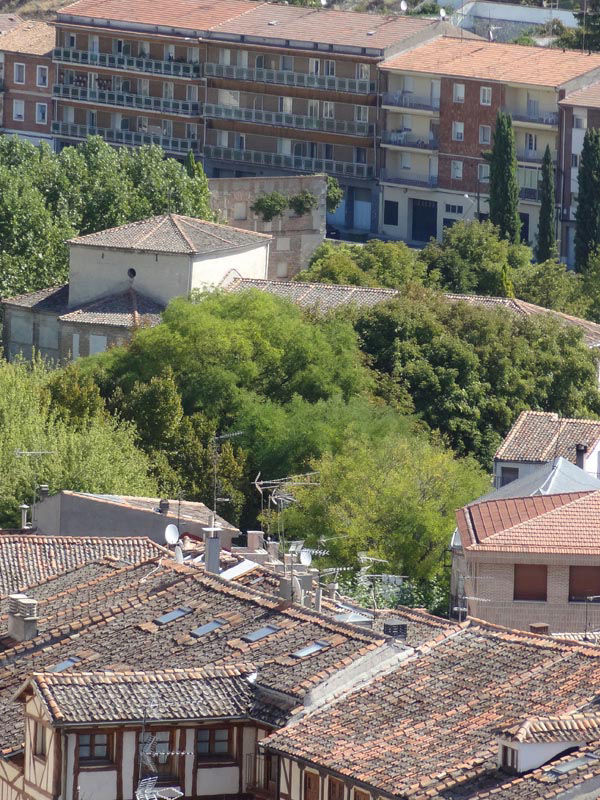
Convent of Saint Francis
A place visited by kings and nobles, General Councils were celebrated at its gates and the church was used as a burial place for renowned people such as Lady Mary, sister of King John II. Its most important change and adornment was carried out by the Dukes of Alburquerque, whom used the church's transept as their burial place.
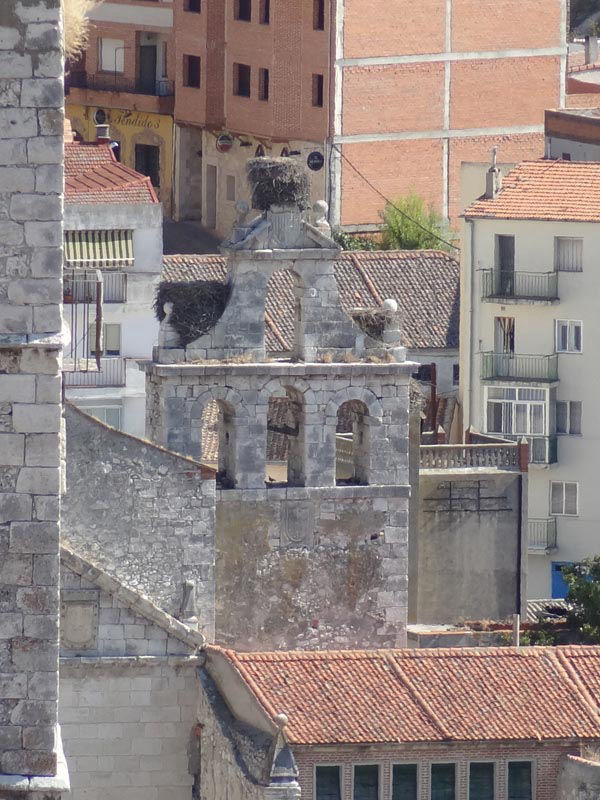
Apse of Santiago
Below this fortified tower, we can enjoy the interior of an apse belonging to a Moorish church with three naves and an atrium featuring brick arches. Investiture ceremonies of Knights were celebrated here and it used to house the archive House of the Eight Lineages.
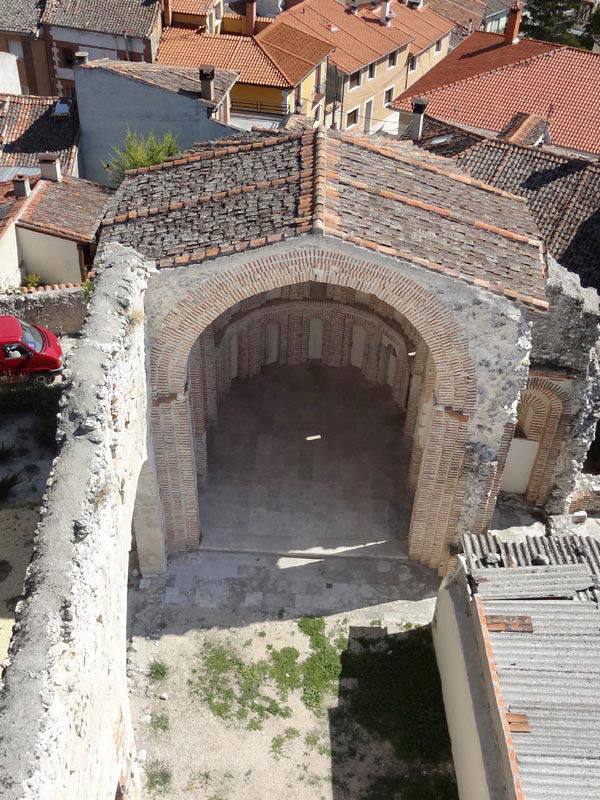
The Church of Saint Michael
The main characteristic that defines this temple is its variety of styles - Moorish, Gothic, Renaissance and Baroque; it also features the first TOWER CLOCK of Spain (14th Century).
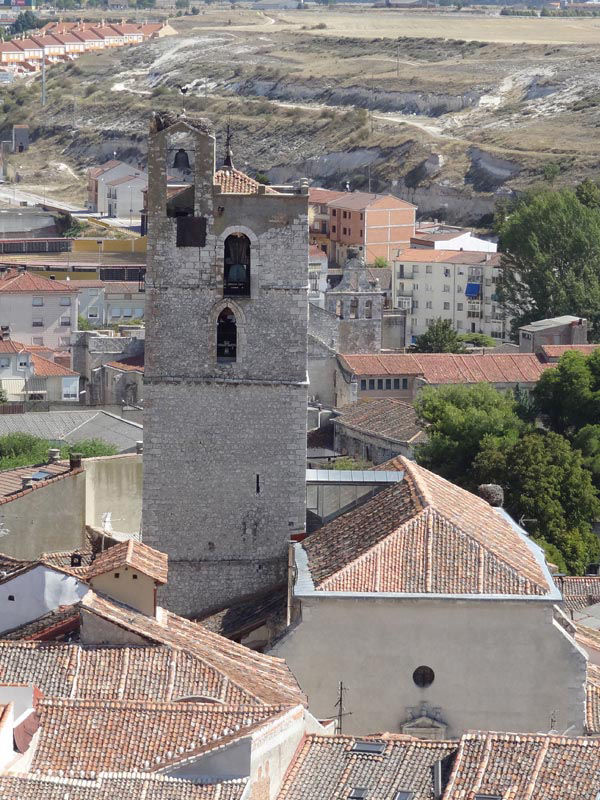
Bullring
The bullring is the last stop of the audioguide designed for running of bulls through the streets, which starts when the bulls leave the corrals - next to the River Cega - led by a group of horsemen through the pine forest until reaching Cuellar, where the runners pick up the baton. Documents from the 11th Century confirm that the CUELLAR´S RUNNING OF BULLS is the oldest in Spain.
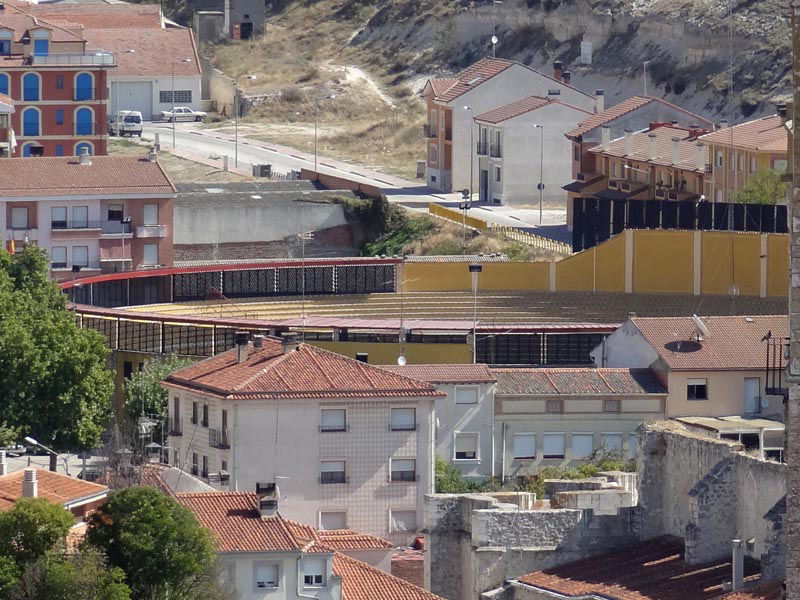
Chapel of Orphan Girls
In the interior patio of a newly built construction, which can be accessed by the public with the audioguide, is the Chapel that belonged to the former school of Orphan Girls This Chapel still preserves the 18th Century Rococo-style altarpiece of the Virgin of Henar.
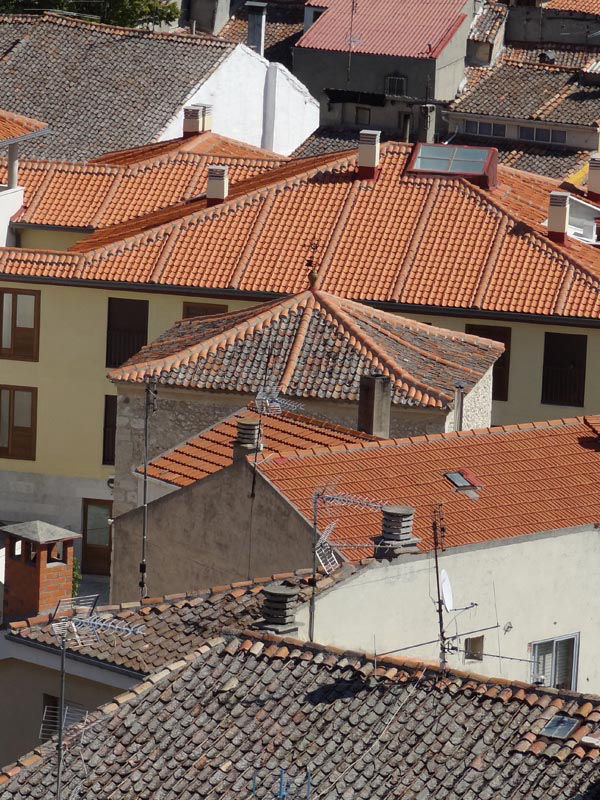
Palace of Lord Peter I
It is considered one of the clearest examples of civil Romanesque in Castlle and Leon. Its paired windows, Romanesque door and Moorish coffering stand out.
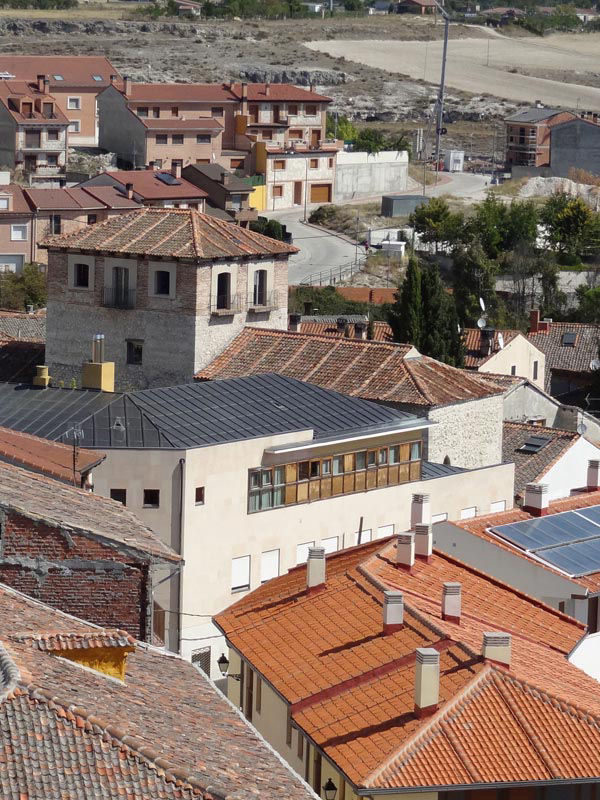
House and granary of the Dukes of Alburquerque
This building was built in the late 18th century and was used as a second residence by the Dukes. Its granaries where used to store grain.
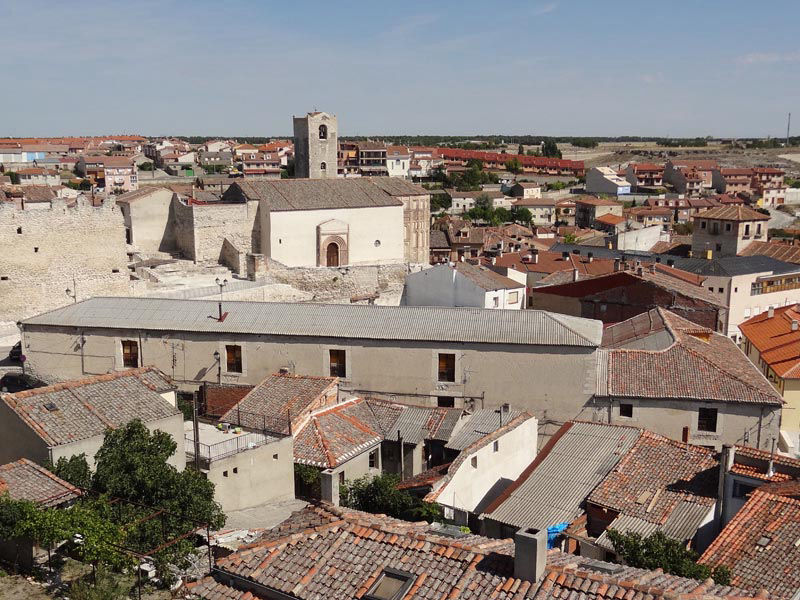
The Church of Saint Steven
The audioguide now shows us one of the most important Moorish churches in Cuellar. Its large brick apse decorated with arches and coffers stands out. Its interior still preserves four tombs decorated with Arabesque features and covered by lying sculptures of deceased figures. Several mummified remains were found inside during its last restoration in 2008.
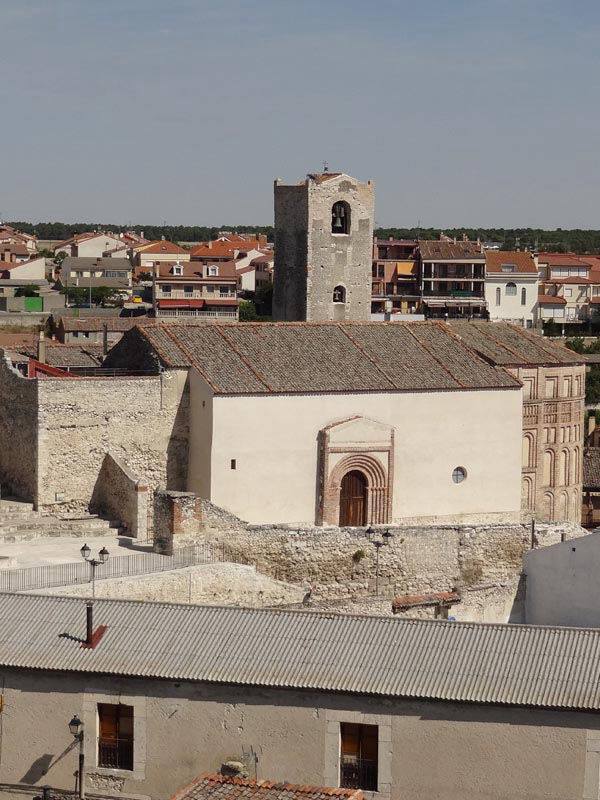
Archaeological Park of Saint Steven
The necropolis with tombs excavated in tufa and dating back to the middle ages has been turned into an Archaeological Park. This park has tombs, silos dug in the limestone that were used to store grain, and basins destined to dye wool and fabric.
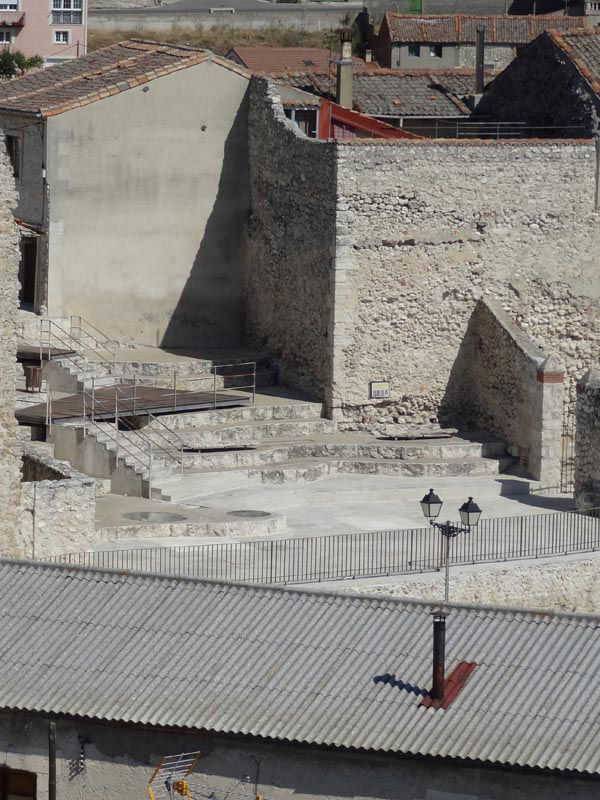
Walls
We end this bird's eye view of the Town where the walls meet the Church of Saint Steven to enjoy the impressive height of these defensive elements, which exceeded 13 meters in height. The audioguide continues in the next stop.
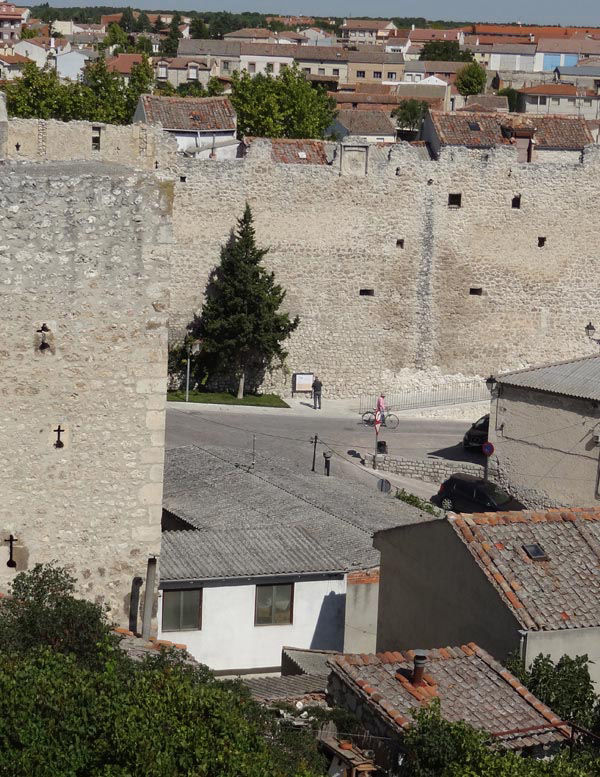
ACCESS FROM THE DOOR OF SAINT BASIL
FIRST STOP: GATE OF SAINT BASIL
From the 12 gates that the walls once featured - six of them in the citadel, the Gate of Saint Basil is the only one that has been preserved practically untouched since the last changes carried out by the Dukes of Alburquerque. It was originally called the Gate of Robledo; when the Convent of Saint Basil was built in the 18th Century, it was renamed the Gate of Saint Basil.
Its Toledo-type Moorish architecture is predominant; the layers of bricks among the limestone and mortar stonework, the brick arches with wide layers of lime mortar and the passageways towards the parapet walks stand out.
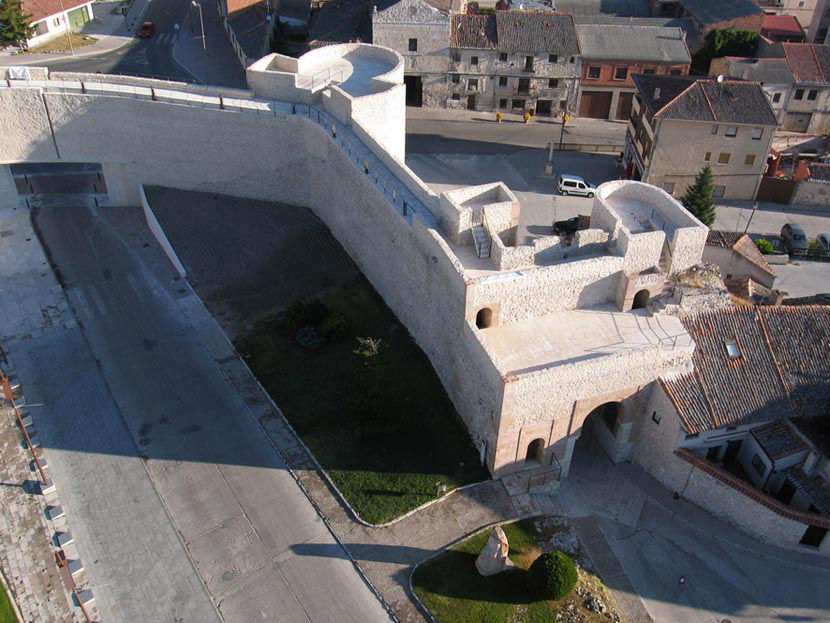
This defensive complex is composed of a treble arch flanked by two fortified towers - one rectangular and the other semi-circular - from which both levels of the parapet walks can be accessed with the audioguide via its interior. The gap that housed the portcullis protecting the gate is still preserved between two arches. Above the gate is the coat of arms of the Dukes of Cueva and Toledo crowning the parapet walk; crowning the exterior brick arch is the coat of arms of the Council of Cuellar.
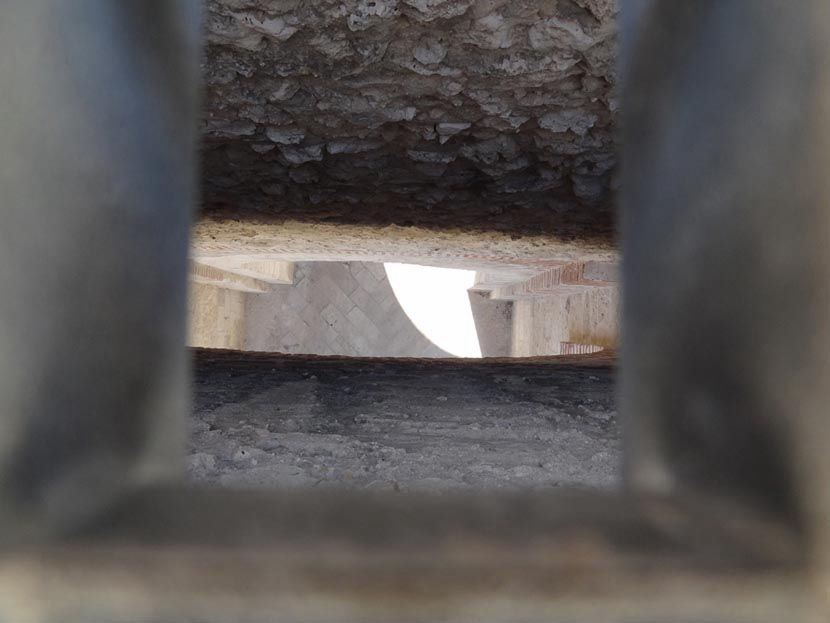
The gate's defensive elements are completed by the semi-circular fortified tower that, reinforced with two small towers, is to the northeast of the gate between the wall and the barbican. This fortified tower has a passageway at its base that crosses through and which was used as a death trap.
The Press
Attached to the wall, although from more modern times, are the remains of a wine press which still features the tiles of a basin where grapes were deposited and a small basin into which the must was poured.
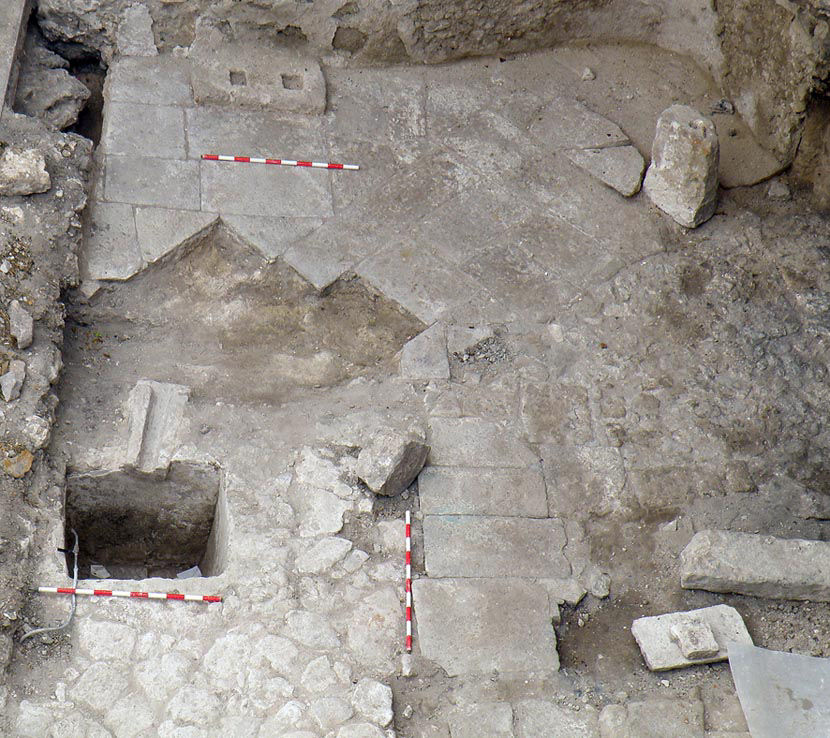
SECOND STOP: THE ARRABAL OF SAINT ANDREW
From this point of the wall with the audioguide, we have a view of the north quarter of the Town, which was built in the outskirts of the citadel around the Church of Saint Andrew and the Convent of Saint Basil.
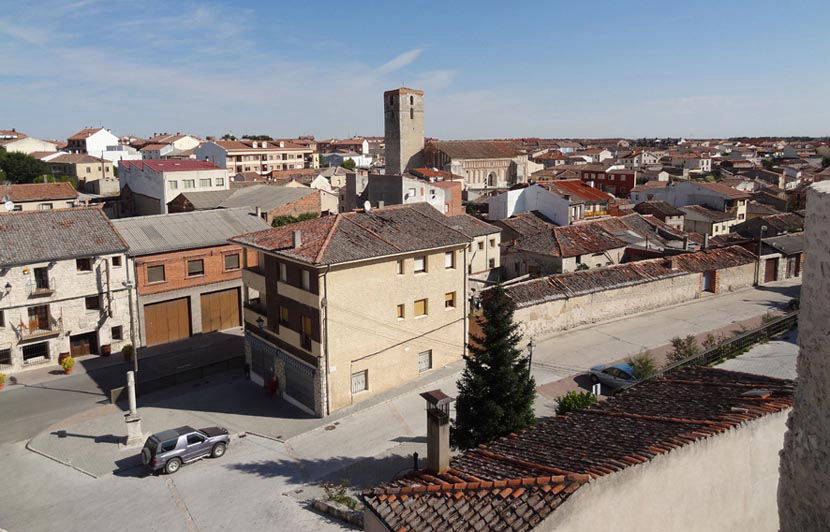
Convent of Saint Basil
The primitive Convent of Saint Basil, also known as Virgin of Health, and founded in the 13th Century, was destined to the Basilian monks that were next to the Cega River. In 1606, the monks moved to the new convent erected in the outskirts of the Town, next to the Gate of Robledo or the Gate of Saint Basil.
The church had several images and relics; the image of Virgin of Rochela stands out. This Gothic-style image was brought from the French city of La Rochelle.
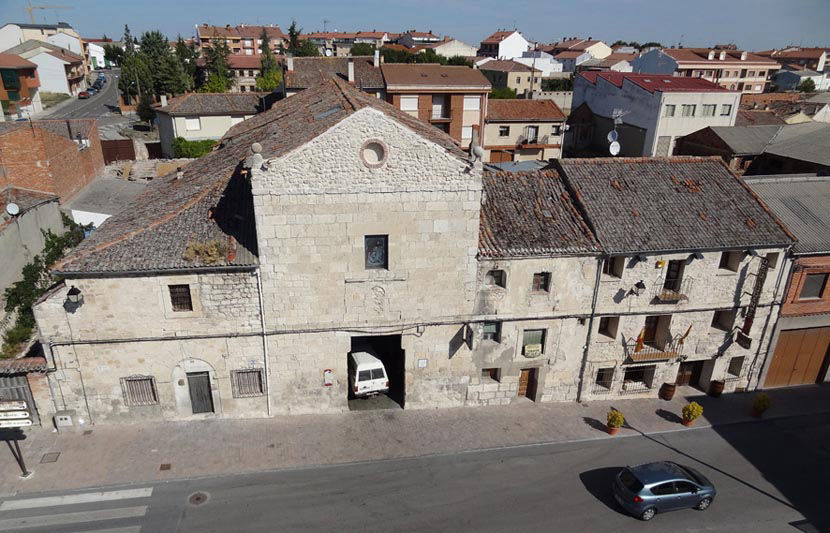
The Church of Saint Andrew
This church you discover with the audioguide is considered as the clearest and most complete example of Moorish architecture in our region; it also has Romanesque features in its portals and socle. Its ground plan consists of a central nave with two transepts completed by three apses decorated with a series of brick blind arches - a decoration that extends to the walls of the naves. It is one of the few examples of Moorish architecture that the west brick façade has. Inside the temple, interesting polychrome murals and a wide collection of sculptures can be seen: the Christ of Saint Gil, the Virgin of Rochela and an important Byzantine-style Calvary.
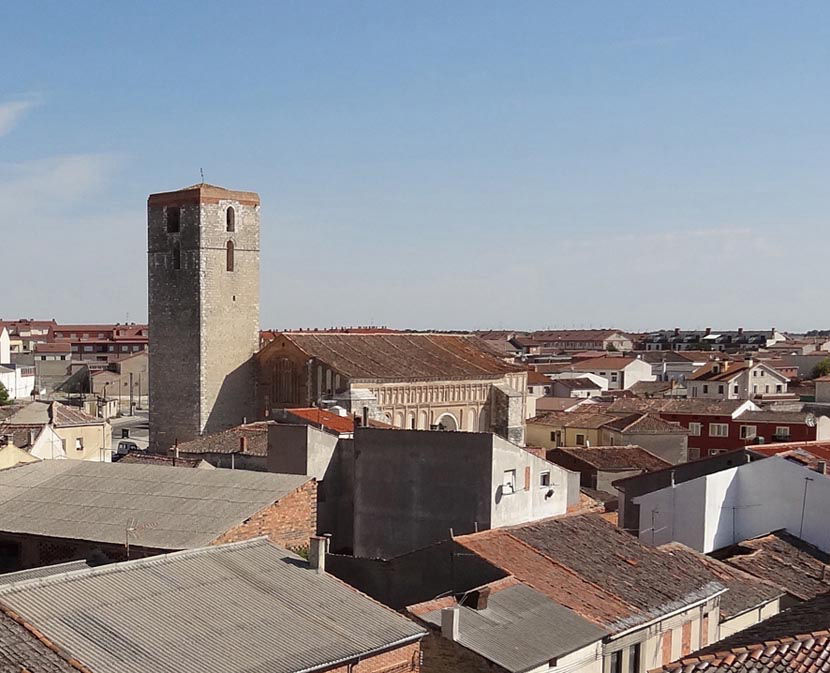
Arch of Saint Andrew
Although only this Moorish arch remains, it was part of one of the gates comprising the second wall enclosure that facilitated its access to the people living in the poor neighbourhood of Saint Andrew. From the remains that have been preserved, a semi-circular arch with a brick alfiz, subsequently reinforced with limestone voussoirs, stands out; the arch keystone features the coat of arms of the Council of Cuéllar.
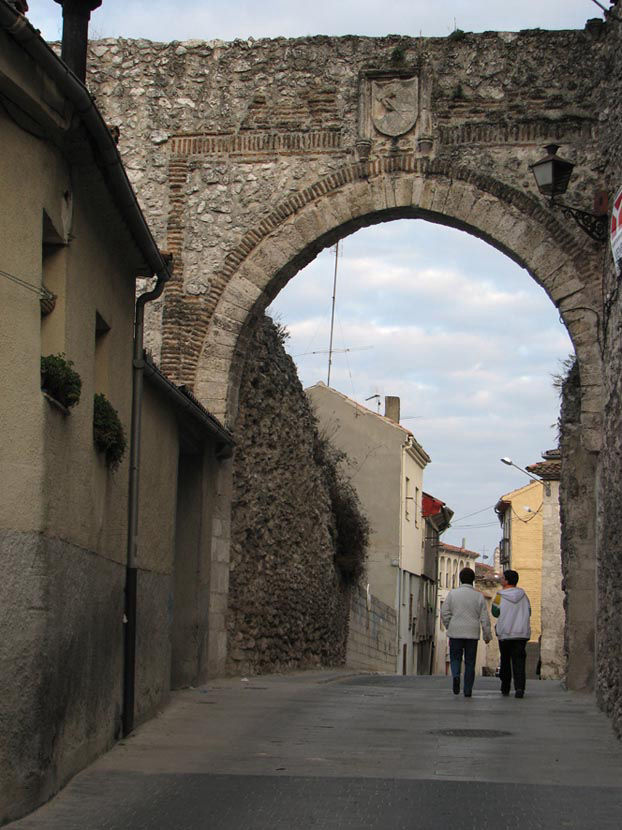
Wall of The Barrier Street
The wall of the first enclosure next to Barrier Street went from the Gate of Saint Basil, towards the east, to the Gate of Saint Andrew. A Moorish fortified tower and an extension of the wall are the only elements that have been preserved, that you can see with the audioguide. The stonework course missing from Saint Basil coincided with the beginning of the housing in The Barrier Street.
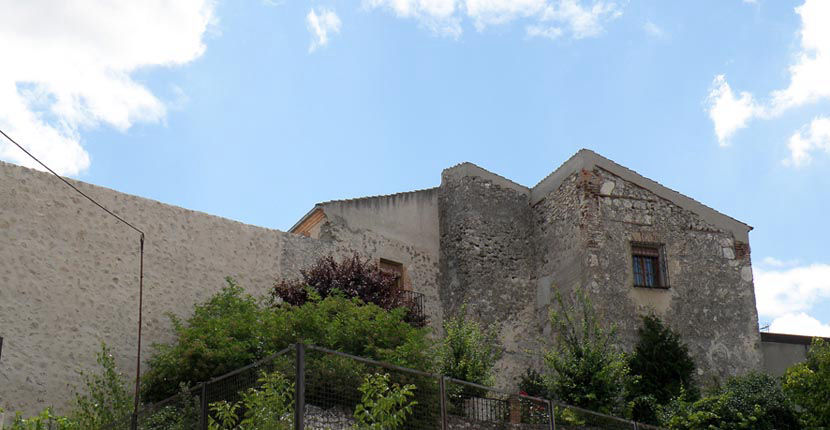
THIRD STOP: THE CASTLE ESPLANADE
What is known as Showground is the space in front of the castle which has been occupied since the Iron Age. It was first occupied by Celtiberians; remains of several settlements have been found from the 4th to the 1st century BC (tiles, a furnace, loom weights, adobes, housing,...).
When the Old Age began, it was abandoned - possibly forced by the arrival of the Romans - and it was not occupied again until the Early Middle Ages, a period in which it became a meeting point for public events such as tournaments and jousts. During the Contemporary History, it was used as a cattle fair; it is currently the stage for the multisector fair.
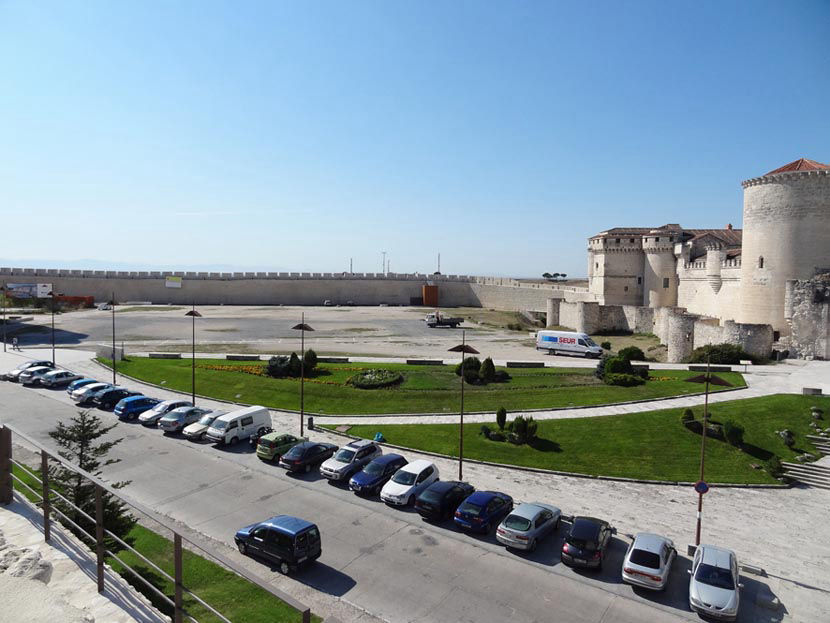
The walls
The esplanade is practically a closed enclosure, as it is surrounded by the walls, the castle and the Church of Saint Martin. Although it has not been proven, some scholars have suggested the existence of another wall in this esplanade that, from the Gate of Saint Basil, continued towards the tower of the Church of Saint Martin and ended at the gate that gave access to the Duke's Gardens.
Both extensions of the wall can be currently visited with the audioguide, which start from the castle and close the first wall enclosure of the medieval citadel. The main access to the citadel from the exterior was carried out using the Gate of Saint Basil, where there was an opening in the south wall that connected the esplanade directly with the Duke's Gardens.
The castle
The impressive bird's eye view of the castle is an invitation to discover the secrets hidden in its interior. From this point, we can see with the audioguide the Tribute Tower, the barbican with its moat, the current access to the castle, and in the background the Southeast Fortified Tower or “The Tower of Memory” with characters in costume.
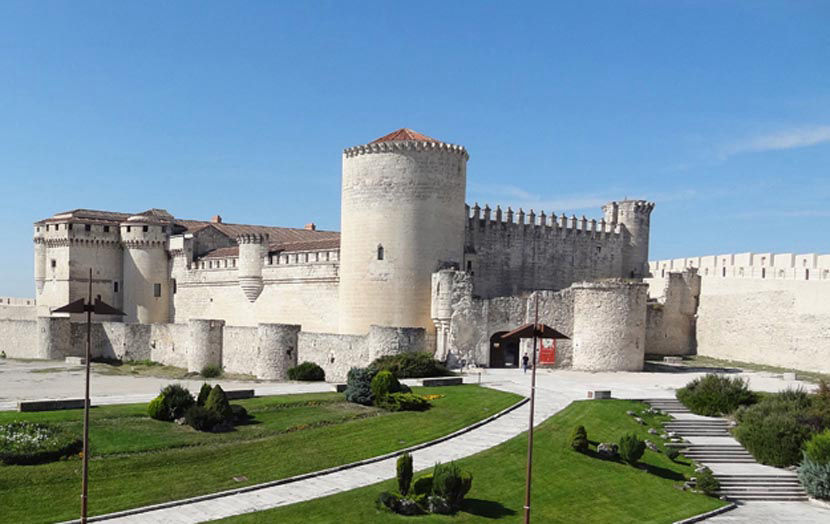
The Church of Saint Martin
This church was erected on a ground plan with a central nave and two closed transept wings with three semi-circular apses, in which, over a stonework socle stand out a series of brick arches doubled in superimposed and squared stretches, which are a characteristic of Moorish architecture in the churches of Cuellar. Its slender tower, built after the temple, stands out and occupies part of the Moorish atrium on the west side of the church. Nowadays, this church houses the Interpretation Centre of Moorish Art, a beautiful trip through the Middle Ages via images, music and sound.
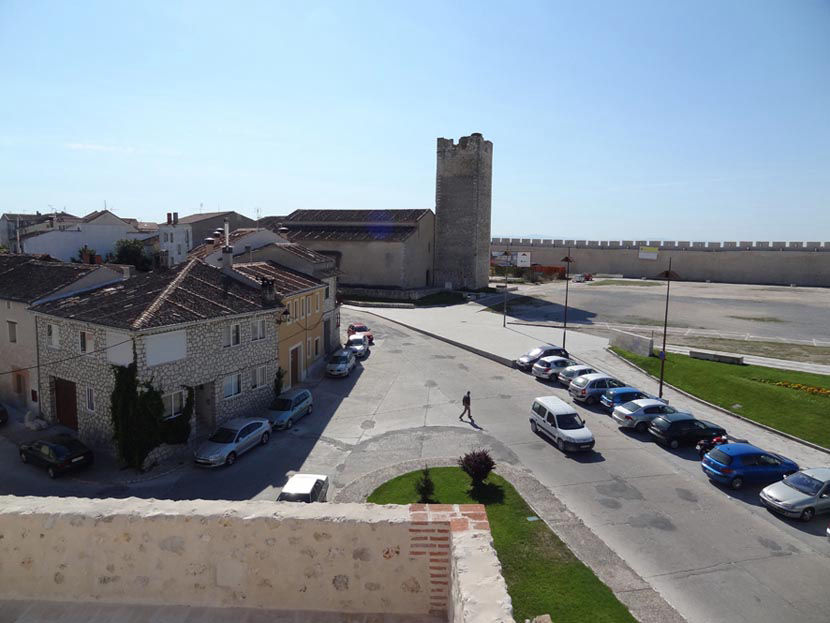
Bluehertz Audio guides has developed for Cuellar´s town hall an audio guide service avaliable in Spanish and English languages.
Cuellar´s Tourist Office address: (inside the castle): C/ Palacio, s/n. Castillo de Cuéllar, 40200 - Cuéllar, Segovia.
- Tel.: +34 921 142 203 - turismo@aytocuellar.es - www.cuellar.es -
Back to index